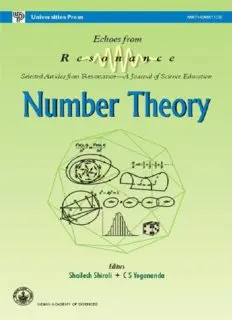
Number Theory by Shailesh Shirali echoes from Resonance Selected Articles C S Yogananda Universities Press PDF
Preview Number Theory by Shailesh Shirali echoes from Resonance Selected Articles C S Yogananda Universities Press
Number Theory For our entire range of books please use search strings "Orient BlackSwan", "Universities Press India" and "Permanent Black" in store. Number Theory Editors Shailesh Shirali CS Yogananda Universities Press (India) Private Limited Registered Office 3-6-747/1/A & 3-6-754/1, Himayatnagar, Hyderabad 500 029 (A.P.), INDIA e-mail: [email protected] Distributed by Orient Blackswan Private Limited Registered Office 3-6-752 Himayatnagar, Hyderabad 500 029 (A.P.), INDIA e-mail: [email protected] Other Offices Bangalore, Bhopal, Bhubaneshwar, Chennai, Ernakulam, Guwahati, Hyderabad, Jaipur, Kolkata, Lucknow, Mumbai, New Delhi, Noida, Patna © Universities Press (India) Private Limited 2003 First published 2003 Reprinted 2008, 2010 eISBN 978-81-7371-983-7 e-edition:First Published 2015 ePUB Conversion: Techastra Solutions Pvt. Ltd. All rights reserved. No part of this publication may be reproduced, distributed, or transmitted in any form or by any means, including photocopying, recording, or other electronic or mechanical methods, without the prior written permission of the publisher, except in the case of brief quotations embodied in critical reviews and certain other noncommercial uses permitted by copyright law. For permission requests write to the publisher. Contents Foreword Preface 1. On Provability versus Consistency in Elementary Mathematics SHAILESH A SHIRALI 2. To find Four Distinct Positive Integers such that the Sum of Any Two of them is a Square S H ARAVIND 3. Bachet's Problem B BAGCHI 4. Mathematical Induction-An Impresario of the Infinite BSURY 5. On the Infinitude of Prime Numbers - Euler's Proof SHAILESH A SHIRALI 6. On Fermat's Two Squares Theorem SHAILESH A SHIRALI 7. Fermat's Two Squares Theorem Revisited B BAGCHI 8. Factoring Fermat Numbers -A Unique Computational Experiment for Factoring F 9 C E VENIMADHAVAN 9. The Class Number Problem - Binary Quadratic Forms RAJAT TANDON 10. The Class Number Problem - An Introduction to Algebraic Number Theory RAJAT TANDON 11. Roots are Not Contained in Cyclotomic Fields RAJAT TANDON 12. Die ganzen Zahlen hat Gott gemacht - Polynomials with Integer Values B SURY 13. Prime Representing Quadratics N V TEJASWI 14. The Congruent Number Problem V CHANDRASEKAR 15. Fermat's Last Theorem-A Theorem at Last! C S YOGANANDA 16. Some Unsolved Problems in Number Theory - Progress Made in Recent Times K RAMACHANDRA When and Where the Articles Appeared in Resonance Foreword The Indian Academy of Sciences launched Resonance as a monthly journal devoted to science education in January 1996. Resonance is aimed largely at undergraduate students and teachers of science, though material of interest to somewhat younger students is also included. Each issue contains papers that span a wide area of science and mathematics, in various formats. Some are individual general articles, others consist of series with several parts. An effort is made to ensure good expository quality in all of them. "Echoes from Resonance" is a series of books born out of Resonance, by putting together in a coherent manner a collection of articles (both series and single pieces) taken from Resonance, all written around a common theme. Typically, the individual articles would have appeared quite independently at different times. These collections should prove useful to a reader who is keen to learn about a specific subject, with accounts given by different authors from different perspectives, but all in an expository manner. We hope these volumes would be useful for students and teachers alike, and that they will complement the structure of individual issues of Resonance which cover different areas of science and mathematics in a balanced manner. N. MUKUNDA Preface Number theory has been a subject of study by mathematicians from the most ancient of times. In the Plimpton 322 clay artefact, excavated from the ruins of ancient Babylon, one finds a systematic listing of a large number of Pythagorean triples—triples (a, b, c) of positive integers such that a2 + b2 = c2; they appear to be listed in order of increasing c∕a ratio. (One sees in the table the beginnings of trigonometry.) The Greeks had a deep interest in number theory. Euclid’s great text, The Elements, generally considered as a book only on Geometry, actually contains a fair amount of number theory too; in particular it contains the proofs of two gems discovered by the Greeks–the irrationality of 2 and the infinitude of the primes. It also contains a description of the algorithm now known as the Euclidean algorithm, which computes the greatest common divisor of two given numbers. In ancient India too there was much interest in number theory, particularly in Diophantine equations; for instance, in the linear two-variable equation ax + by = c, where a,b,c are given integers, and in the equation later to be known as the Pell equation (x2 – Ny2 = 1, where N is a given positive integer). Building on the work of Brahmagupta (6th century) Bhaskara II (12th century) gave a completely general way of solving the latter equation. In this book we offer the reader some articles in number theory that appeared in Resonance over the years 1996–2001. Traditionally, number theory begins with a study of congruences (Wilson’s and Fermat’s theorems, the Chinese remainder theorem, quadratic residues, primitive roots, …), then proceeds to a study of prime numbers (the infinitude of various classes of primes, divergence of the sum ∑ 1∕p taken over all primes, …) and later to a study of Diophantine equations (solution of equations such as x2 + y2 = z2, ax + by = c, where a,b,c are given integers, Pell’s equation …). The last two topics (prime numbers, Diophantine equations) are distinguished by the extraordinary diversity in terms of level of difficulty, of the problems they offer to the students. There is something in number theory for practically
